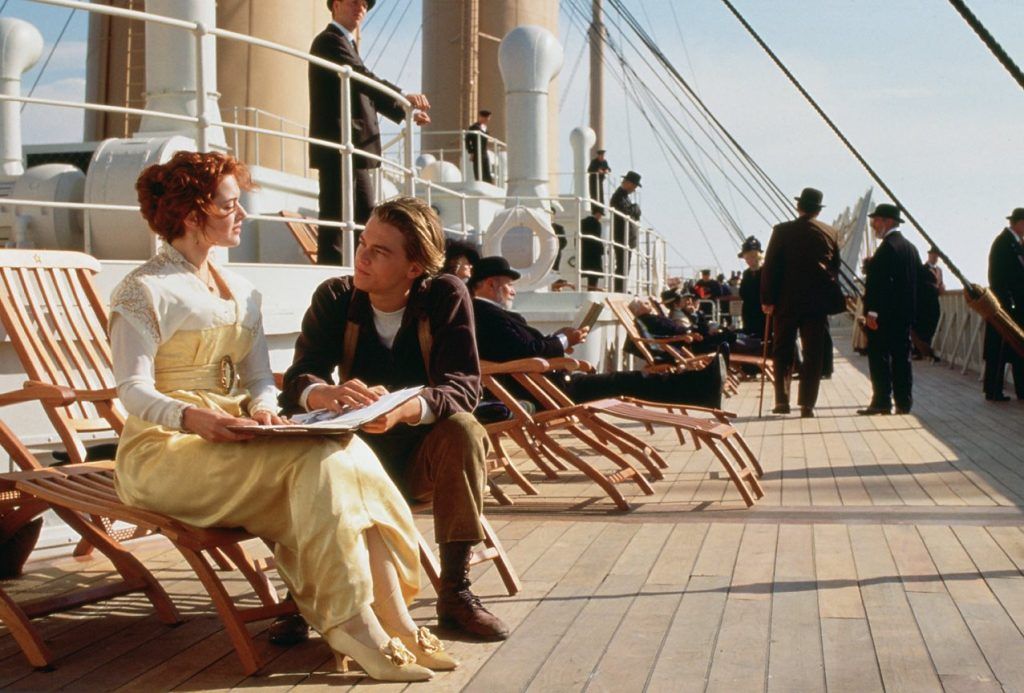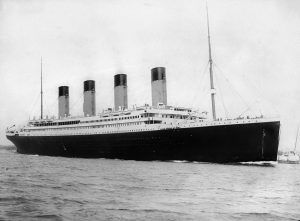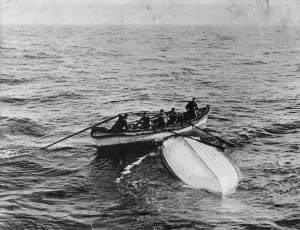What we can learn about climate change from the Titanic
By Dawn Stover | February 15, 2019
 Kate Winslet and Leonardo DiCaprio starred in the 1997 film Titanic. Credit: Paramount Pictures
Kate Winslet and Leonardo DiCaprio starred in the 1997 film Titanic. Credit: Paramount Pictures
I recently shared the latest news about climate change with my Facebook friends, writing this: “The five warmest years in recorded history have been the last five, and 18 of the 19 warmest years have occurred since 2001.” One of my friends commented that it reminded him of those people who were rearranging the deck chairs as the Titanic sank. Are climate deniers their modern equivalent?

The climate ship has definitely sailed: Even if we could eliminate all carbon emissions overnight, the planet’s average temperature and sea level would not decrease in the coming decades, because of the inertia built into the climate system. As with a massive ship, you can’t wait until the last minute to start steering away from disaster. But even on the doomed Titanic, there would have been many more survivors if the right actions had been promptly taken, and the same is true today for global warming.
As a matter of historical fact, the Titanic’s 614 wood-and-wicker chairs were probably tied up for the night when the ship began sinking. The first reference to “rearranging the deck chairs” did not appear in print until the late 1960s. Nevertheless, the expression has since come to describe futile actions taken in the face of impending catastrophe. Like, say, President Trump calling for “forest clearing” to address wildfire risks in California—where the deadliest recent fires, made worse by climate change, did not happen in forests. The phrase remains an all-too-accurate description of the little that is being done to stabilize our planet’s climate.
More should have survived. The RMS Titanic struck an iceberg in the middle of the night and sank in less than three hours on April 15, 1912—taking 1,517 men, women, and children to their deaths. Only about 700 people survived. The ship’s designer and captain went down with the ship, but the president of the company that built the Titanic survived (much to his regret), as did more than 60 percent of his fellow first-class passengers. By comparison, only 25 percent of the passengers in the ship’s third class survived. The ship was on its maiden voyage from Southampton, England to New York City.

Whether or not the Titanic collision was avoidable remains a matter of debate. The ship might have been going too fast. The radio officer might have been paying too much attention to sending personal messages for wealthy passengers and too little attention to iceberg warnings from other ships. The lookout might have spotted the iceberg sooner if he had binoculars. The crew might have waited a half-minute too long to turn the ship, or turned too hard, or turned in the wrong direction, or reversed the engines when it would have been better to maintain forward thrust.
What is certain, however, is that hundreds more people should have survived the collision. They went down with the ship because of poor planning and lax regulation. That is precisely what will kill millions of people around the world, most of them traveling in steerage, so to speak, in the absence of immediate action to keep the planet’s climate system afloat. Our entire economic system is in desperate need of a course correction and more lifeboats. Instead we’re getting revised seating arrangements for the passengers who can afford deck chairs.
Stupefying unpreparedness. It’s unfair to blame the passengers of the Titanic for their own demise. Had they scrutinized the newspapers of their day, they would have learned that the ship was the largest built and virtually “unsinkable” (although the White Star Line never made that claim). We can hardly expect passengers to have packed their own lifeboats for the journey.
Many passengers made unfortunate decisions as the crisis unfolded, however. Some stayed inside while the evacuation was happening. It was cold out, and they believed the whole thing was only a drill. Others realized the ship had been hit but did not understand how quickly it could go down, so they remained onboard to wait for rescue. They put their faith in misinformation, just as many Americans willfully ignore what is happening right outside their windows.
The lion’s share of the blame must be assigned not to the passengers, however, but rather to the ship’s owners, managers, and captain—along with the shipping industry’s government regulators. In their wanton disregard for risk, the responsible parties are not unlike today’s climate deniers.
There were two official inquiries into the sinking: one by the United States Senate and the other by the British Wreck Commissioner on behalf of the British Board of Trade. The latter concluded that the ship’s loss “was due to collision with an iceberg, brought about by the excessive speed at which the ship was being navigated.” The US Senate took a different tack, finding that the disaster was not the result of negligence by the White Star Line or its holding company International Mercantile Marine (bankrolled by American financier J. P. Morgan), but that the ship lacked essential life-saving equipment and “when the crisis came a state of absolute unpreparedness stupefied both passengers and crew.” The Senate blamed a shortage of lifeboats on the British Board of Trade, “to whose laxity of regulation and hasty inspection the world is largely indebted for this awful fatality.”
A chain reaction. As with climate change, the sinking of the Titanic was the result of multiple factors, beginning with a faulty design: The ship’s 16 “watertight” compartments were supposed to keep it afloat even if as many as four of the compartments flooded. However, the bulkheads (dividing walls) of the compartments did not extend all the way to the ceiling. When the iceberg left a large gash in the ship’s hull, so much water entered some compartments that it rose higher than the bulkheads and flooded adjacent compartments.
New designs are often touted as being “safer” than older ones, but increased complexity tends to increase the possibility of unintended consequences—even as it inspires false confidence. In the case of theTitanic, engineers made faulty assumptions about the strength of its rivets and steel hull, both of which ultimately proved to be of poor quality. The hull plates were made from steel that was extremely high in sulfur, which made it susceptible to brittle fracture, especially in ice-cold water.
A botched response. According to survivors, the ship’s captain did not issue a general alarm to warn the crew and passengers that they would need to abandon ship. There was no public address system. Even those passengers who were aware that there was an emergency did not know where to go or what they were supposed to do. The crew did not have a well-oiled plan for launching the lifeboats, which delayed the process. As with the climate crisis, there was an abysmal lack of leadership.
Worst of all, there were not enough lifeboats on the ship. The Titanic was designed to carry 32 boats, half the number needed for everyone on board, but its owners decided to install only 20 boats, so that the deck would be less cluttered. They preferred lounge chairs over lifeboats, and regulators at the British Board of Trade were just fine with that. In fact, 20 lifeboats were more than required by law.
The Titanic’s lifeboats could have accommodated 1,178 people (or more, because it was arguably safe to overfill the boats in the flat-water conditions that prevailed on the night of the accident). That’s almost 500 more people than actually survived. The first lifeboat to leave, with a capacity of 65, took only 27 people, and others also left half-filled. Only two boats returned after launch to pick up more people. And of the 20 boats carried by the ship, only 18 were launched successfully. One overturned during a last-minute launch attempt, and another floated away empty.

Although they differed in assigning blame, the two official inquiries into the Titanic’s sinking agreed on the need for stronger hulls and better safety practices, including a requirement that ships carry sufficient lifeboats and rafts to accommodate everyone onboard. That’s a no-brainer for ships, but doesn’t everyone on Spaceship Earth also deserve a chance to live?
Unfortunately, you don’t have to look far to find modern examples of government policy makers and regulators who are failing to heed scientific warnings intended to protect the public from harm, and then struggling to cope with climate-aggravated disasters such as increasingly intense wildfires, hurricanes, heat waves, and flooding. An October 2018 United Nations report warned of dire climate consequences if the global economy is not transformed at an unprecedented speed and scale. And even that report may have understated the risk, because it ignored the possibility of runaway warming.
Icebergs ahead. There will be no shortage of icebergs to dodge in the future, both real and metaphorical. Greenland, the most likely source of the Titanic’s nemesis, is melting. And that’s just one of the many impacts of global warming—the tip of the iceberg, so to speak.
Unfortunately, as on the Titanic, government regulators and business executives today are more concerned with catering to the wealthy than with ensuring human survival. First-class passengers on the ship wore top hats, furs, and diamond necklaces to their 11-course dinners, while the poorest passengers—immigrants slated to be offloaded at Ellis Island before the ship docked in Manhattan—were relegated to the lower deck. In the movie, the fictional Jack Dawson and Rose Dewitt Bukater fell in love across the class divide, but the real ship was a microcosm of a society in which third-class passengers did not mingle with the first class.
As in 1912, “survival of the richest” still applies. Instead of pushing for action to stabilize the climate, some of the wealthiest Americans are building bunkers, hiring security guards, buying private planes, and trying to figure out how to escape the worst impacts. The only thing that has changed is that women and children no longer get the first seats on these lifeboats.
Some students of the disaster have suggested that it might have been possible for all passengers and crew aboard the Titanic to have survived, if they had immediately set about constructing rafts from furniture, doors and other ship parts, and life jackets. The ship’s baker, who survived by clinging to an overturned lifeboat, testified that he had thrown dozens of deck chairs into the ocean, hoping people could use them to stay afloat. But the water was numbingly frigid, and by that point it was too late.
Together, we make the world safer.
The Bulletin elevates expert voices above the noise. But as an independent nonprofit organization, our operations depend on the support of readers like you. Help us continue to deliver quality journalism that holds leaders accountable. Your support of our work at any level is important. In return, we promise our coverage will be understandable, influential, vigilant, solution-oriented, and fair-minded. Together we can make a difference.
Keywords: climate change
Topics: Climate Change, Columnists















Yes, I read about how the improper design doomed the ship.
Since it’s too late to fix, can we stop obsessing about carbon credit markets and focus on technological survival tools? Climate is going to change no matter what we do, so let’s stop whining about who and what’s to blame, and NOT fix anything with the nifty world fascist state that seems to be the only proposed solution, and actually do something to mitigate the effects.
So what exactly are the proscriptions for avoiding the metaphorical iceberg and escaping the metaphorical shipwreck? . . .
Your report about the fateful voyage of the RMS Titanic provides a powerful example for teaching about climate change — showing that for every disaster there is no single cause, but a number of overlapping or sequential events which combine to bring about a catastrophic result. We are only now beginning to fully understand the way in which the earth-ocean-atmosphere is responding to the huge volume of greenhouses gases being emitted daily, even though we knew the approximate outline of what was happening some 20 – 30 years ago. As the number of observations exponentially increases, and climate models are… Read more »
Fantastic idea!
I taught safety regulation for over 40 years and lectured on the TITANIC many times. I can agree with everything you say but I would put the emphasis differently. TITANIC was doomed because of the incredible, arrogant, brain dead, self centered imbecilic, greedy stupidity of all of the senior MEN (and yes they were all men) involved in the design, construction, regulation, operation and even the post disaster investigation of the Titanic. Denial, delay, coverup, obfuscation and outright fabrication were found at every stage of the process. The Grenfell towers fire shows almost exactly the same characteristics. Perhaps we do… Read more »